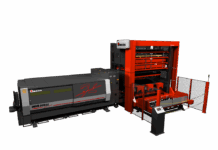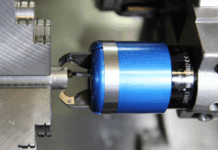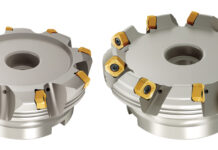The SA-78NCe high tensile steel tube cutting line together with the DeF-FA/76-V chamfering system can connect to the SOCO BDB-70 deburring system by an automation cell, covering loading, cutting, end-finishing, washing, length measuring and stacking.
Cutting lines with deburring system
In general, the deburring method has been more widely used within the tubing industry. Using wire brushes, the operator can easily remove the burrs at the end of the tubes through manual and automatic systems and for single or double tube ends.
The brushes are able to reach the entire surface, both internal and external through different movements that are perpendicular to the tube, as well as remove burrs on the face of the tube. Variations of this process may include different types of brushes for specific applications, as caused by requirements such as deeper burr removal depths, tube material and deburring cycle time. Further automating existing cutting processes, SOCO offers the SA-78NCE high speed cutting line together with the SOCO BDB-70 double tube ends deburring machine. This powerful combination is capable of cutting and deburring various tube shapes and profiles such as round, rectangular, square and oval tubing.
Cutting lines with chamfering system
Tube chamfering usually involves a set of tooling made to size, clamping the part while the chamfering head moves in and out of the tube ends.
It is able to form an exact chamfering angle, allowing the tube to fit into other parts for future processing. It may also chamfer the external and internal parts of the tube, while creating a smoothened surface. It can also be executed with one or two sides of the tube at the same time. Since the stroke of the chamfering head may sometimes be controlled, so can the tube length after cutting and chamfering, as well as the chamfering depth. In SOCO, besides the standard functions of SA-76NC, the SA-76NC in-line may also be a part of complete Automation Cells for tubing. The working process includes loading, feeding, cutting, chamfering, deburring , air clearing and tube collecting. It brings time saving as well as higher throughput and performance.
Co-existing solutions
Until recent years, the deburring process through wire brushes has been the preferred method due to its encompassing range and in general, it also required less set-up time. However, as production requirements changed, and through new developments in the chamfering field, the deburring systems have been gradually replaced by chamfering machines in high production environments for different reasons and needs. Overall, both end finishing processes will continue to co-exist in the global market for different requirements and needs, but it is up to each company to decide and choose the most suitable and efficient method for their production environment.

For more information, contact PIM – Tel: 011 022 4648








